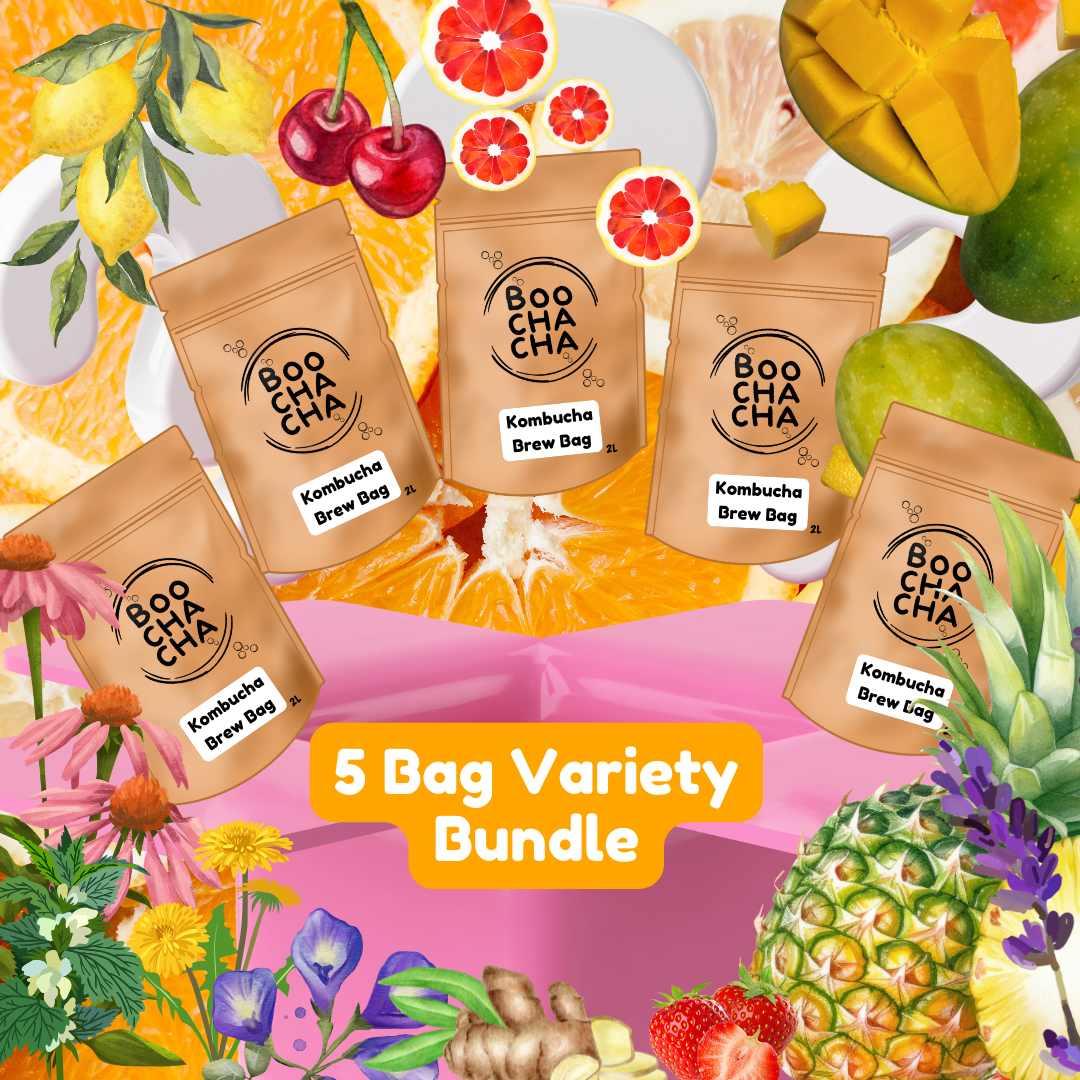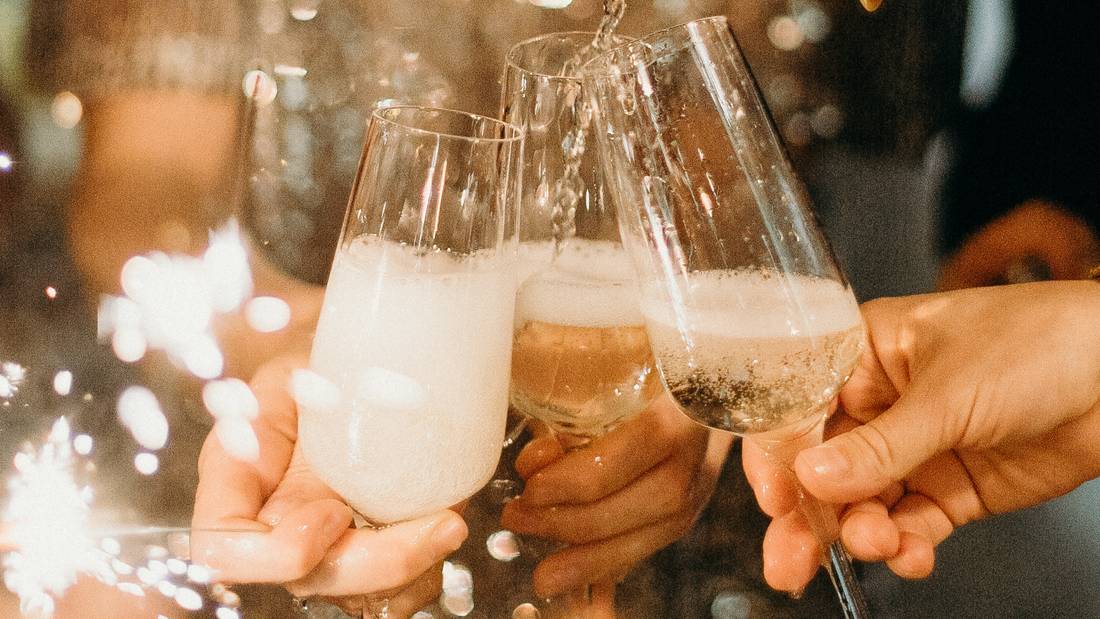I know it's only October, but if you want to enjoy homemade champagne style Kombucha at Christmas this year (who wouldn't, it's the perfect, healthy, easy to make and a very low alcohol champagne replacement option), then now is the time to get bottling.
By starting the bottling process now, your Kombucha will have plenty of time (6 - 12 weeks) to go through its second fermentation and develop a bottle-popping, natural fizz, and with added festive flavours, and it will be sure to impress all your family and friends.
If you aren't brewing your own Kombucha yet, we are famous for our 5 star rated, beginner friendly Kombucha Starter Kits, which always come with a lifetime of brewing support.
If you get started with your kit now, you'll just about have enough time to get your Kombucha brewed and ready for turning into the perfect, homemade, very low alcohol champagne replacement (which also happens to be very good for your gut).

When bottling for these longer time periods, we recommend using fermentation safe glass bottles with plastic lids (we can only vouch for the ones we sell).
Plastic lids have a little bit of flex, which allows the carbonation to build safely during fermentation, and you can actually see when that pressure is forming in the bottle (you'll see an egg forming on the lid), which helps you avoid the dreaded Kombucha bottle explosions (we have the perfect set of bottles and lids here).

The Secrets to Fizzy Homemade Kombucha
The second fermentation is where the magic happens. This stage is always done once the Kombucha has already been brewed (get ahead with one of our famous Kombucha Starter Kits or see our free guide on getting started with homemade Kombucha here) and is done in glass bottles with lids which are air tight (instead of the breathable lids which are used for the first fermentation).
This is the stage that adds natural carbonation and lets you infuse your Kombucha with whatever fun flavour combos you fancy!
In this blog we are talking about making very fizzy homemade Kombucha, by using a long second fermentation period. This secondary stage will typically lead to slightly higher alcohol levels than normal, possibly up to 3%, although the highest alcohol percentage we have managed to brew is 1.6%.
It is actually very hard to get authentic homemade Kombucha brewed to high levels of alcohol without adding another strain of yeast (you actually have to get the alcohol of Kombucha measured in a lab as a hydrometer doesn't work due to the presence of organic acids in the brew), but this is an important factor to keep in mind if you’re serving your homemade Kombucha to people who avoid alcohol.

If you'd like to add a more gentle fizz to your Kombucha with shorter second fermentation times we have a guide for that here.
See our Kombucha Recipe Club here for inspirations.
So to get a good fizz into your Kombucha, we need to allow the fermentation to continue (so bottles must be stored at room temperature), carbon dioxide will start to build up inside your (sealed) bottle which eventually builds pressure (hence why you see your egg form on the plastic cap), and so a few safety steps are important:
- Most important thing to do is use a fermentation safe lid and bottle. We do not recommend flip top glass bottles for long fermentations as you cannot see the pressure build up like you can with a plastic lid
- Remember that even with a plastic lid, it will not flex forever. Do not forget about your fermenting bottles of Kombucha, or push them too far, once you start to see an egg forming you have got a good fizz going on and it is time to move to the fridge
- Do not overfill your bottles
- For this long fermentation we recommend leaving the bottles at the cool end of room temperature (think 18 - 20 degrees C)
- Store your bottles in a cool box / large plastic container / bag for life tied at top to catch any overflow / explosions
Flavouring your Fizzy Homemade Kombucha
Your Kombucha is going to be doing a long second ferment here, so the flavour tends to lean towards being quite dry, as the sugar content gets very low.
If you like a dry sparkling wine then you could bottle up a plain Kombucha and let that go through the long fermentation. A Sencha Green Tea Kombucha comes out like a dry sparkling white after 1-2 months fermentation and a Rooibos or Rooibos with Hibiscus Kombucha Brew Bag comes out with slightly fruity, honey-like vibes.

You can experiment with a mixture of light and strong flavours for these types of long fermentations, each will develop in a different way as time goes on.
If you add any fresh herbs or fruits we recommend doing this flavouring in another bottle for 5 - 7 days and then straining these pieces out and bottling again with your plastic caps and letting the fizz build up without leaving the fresh ingredients in (we have a great funnel and sieve for that here).
Fizzy Kombucha Recipes for the Festive Period
All of these recipes are to make 330ml of fizzy Kombucha (perfect for brewing in Our Mini Bottle Series and serving for 2 glasses of Kombucha champagne) but you can scale them up or down to suit your need or bottles.
Here are a few recipes to try in for your long second fermentation:
Spiced Orange Kombucha
Add a strip of orange peel, a small piece of cinnamon stick (or a dash of cinnamon powder), and a couple of cloves to your Kombucha in a separate glass bottle. Leave for 5 - 7 days for the flavours to infuse, then bottle with plastic caps and leave for 6 - 12 weeks at room temperature.
Once you start to see a good egg forming against the plastic cap you should move the bottle to the fridge to pretty much pause the fermentation and prevent too much fizz that you can't open the bottle. This Kombucha combo gives a mulled-wine aroma, with a great fizz and a warm feeling.
Cranberry and Rosemary Kombucha
Add a spoonful of crushed fresh cranberries and a small sprig of rosemary to your Kombucha. Leave for 5 - 7 days for the flavours to infuse, then bottle with plastic caps and leave for 6 - 12 weeks at room temperature.
Once you start to see a good egg forming against the plastic cap you should move the bottle to the fridge to pretty much pause the fermentation and prevent too much fizz that you can't open the bottle. This Kombucha combo adds a tartness, beautiful colourful and festive fragrance.

Gingerbread Kombucha:
Add a dash of ground ginger, a pinch of cinnamon, and a drop of vanilla extract to your Kombucha. These can be bottled straight away with plastic caps and left for 6 - 12 weeks at room temperature.
Once you start to see a good egg forming against the plastic cap you should move the bottle to the fridge to pretty much pause the fermentation and prevent too much fizz that you can't open the bottle.
This has all the warming spice of gingerbread cookies in a bubbly, healthy drink.
Apple and Star Anise Kombucha
Add a slice of apple and half a star anise pod for a gentle, lightly spiced flavour that feels cosy and seasonal. Leave for 5 - 7 days for the flavours to infuse, then bottle with plastic caps and leave for 6 - 12 weeks at room temperature.
Once you start to see a good egg forming against the plastic cap you should move the bottle to the fridge to pretty much pause the fermentation and prevent too much fizz that you can't open the bottle.

By getting the bottling done now, you’ll have a whole range of sparkling, naturally flavoured Kombuchas ready to pop open at Christmas.
It’s a healthy, fun, and festive alternative to high alcohol options at Christmas gatherings, it is also a great talking point at the table, and they make great gifts too.


